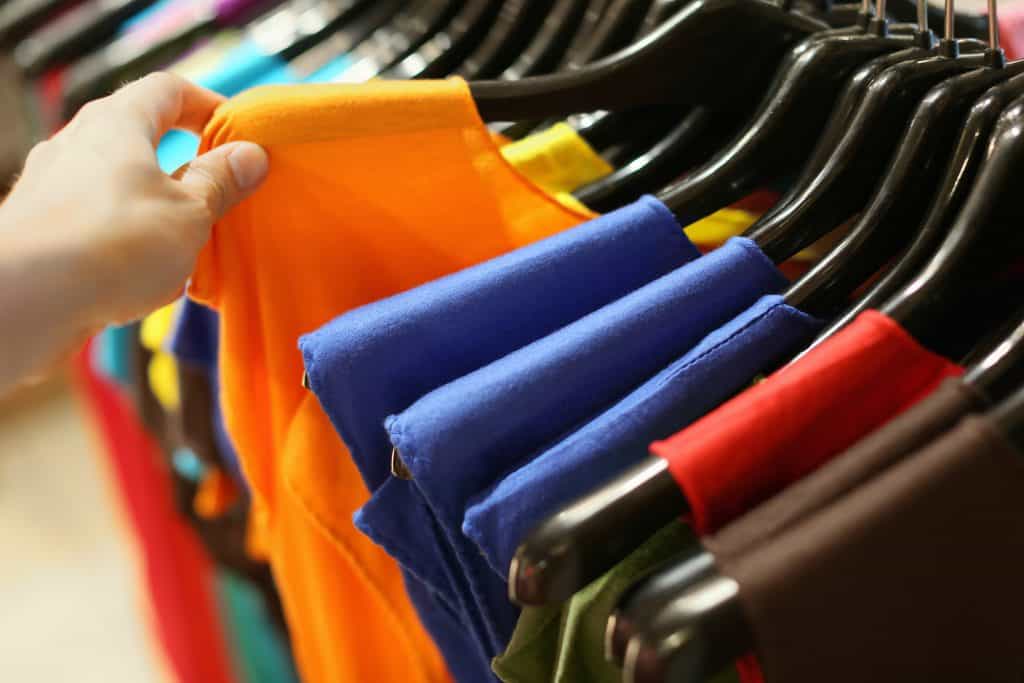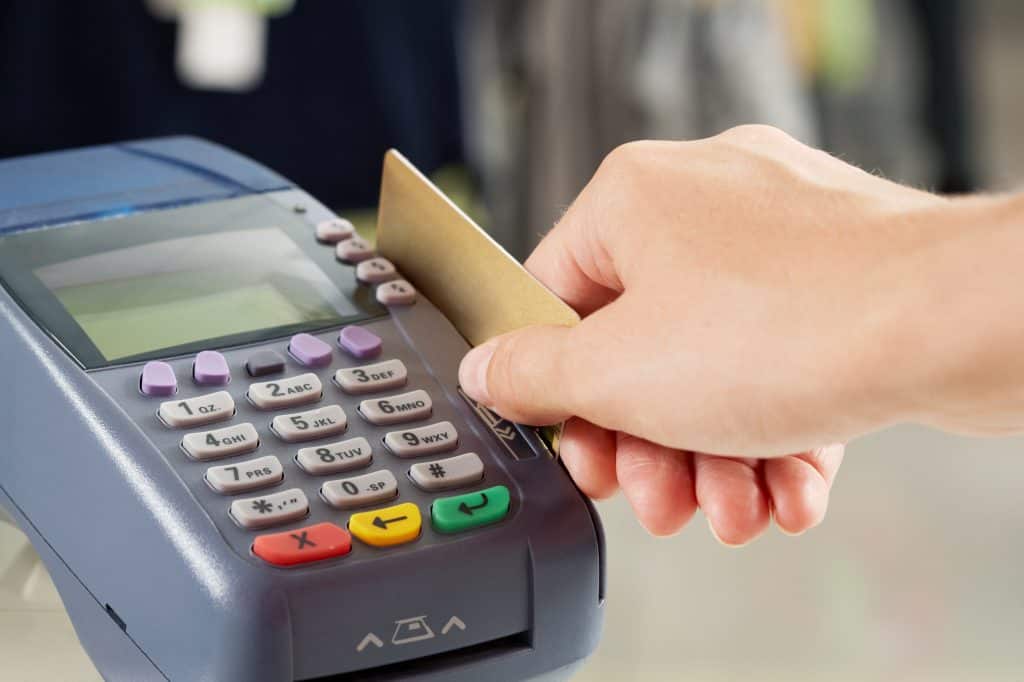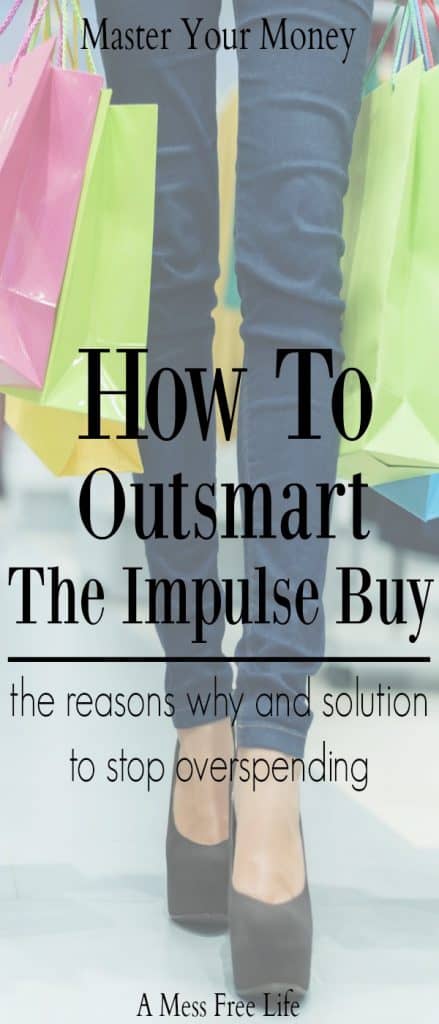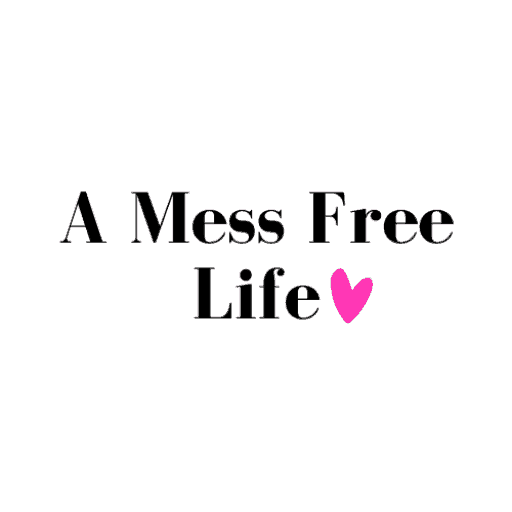A Mess Free Life may collect a share of sales or other compensation from the links on this page.
Have you ever strolled the mall with the best intentions of window shopping, only to arrive home with bags and bags of items? That’s the act of the impulse buy, and there is a high cost associated with the action.
Retail stores are carefully constructed to get you to impulse buy.
Think about how a grocery store is nicely laid out. You have to pass many tempting items just to grab a gallon of milk or toilet paper. Along the way are toys and other higher priced items enticing you to pick them up and throw them in your cart.
It’s not just your local grocer who is playing with your mind and pulling at your wallet. Stores are lightly scented because those beautiful aromas get you to buy more. Stores are even laid out clockwise so that right handed people can quickly grab a cart and start grabbing items with their dominant hand.
Most stores have you walking the isles in the hopes you’ll pick up things you want but don’t necessarily need, but desire.
Buying on impulse is a typical behavior for many people, maybe you too?
It certainly was for me. When I began my overshopping journey, I was the queen of the impulse buy.
I don’t think I ever went to a store and purchased only what I had intended. I always ended up with some other items in my cart, typically many items.
And so this constant state of impulse buying left me with over 50K of credit card debt and a ton of guilt and shame.
Table of Contents
HOW TO OUTSMART THE IMPULSE BUY
What most don’t realize is impulse buying is related to your state of mind.
Impulse buyers are triggered to spend due to anxiety or unhappiness. What makes you spend impulsively is going to be unique for each person, but understanding what triggers you will help you understand and make smarter shopping decisions in the future.
But first, let’s identify why you impulse buy.
YOU LOVE TO SHOP
What most people don’t understand is at the root of their love of shopping is simply their desire of acquiring something new. Think about how empowering it is to make a purchase. Maybe you feel disempowered in other areas of your life, so shopping fills that need to feel in control. The problem is impulse buying is the exact opposite of feeling in control.
YOU WANT TO SAVE
Saving money is great and buying things on sale is the smart thing to do when you’re budgeting and saving money. But, if you’re buying things and justifying the purchase ultimately those justifications lead you to spend money you didn’t budget for.
YOU WANT TO FEEL GOOD
Ads are intended to make you think your life would be better if you had that product. Often, the impulse to buy the product comes from wanting to make good on the promise. You want what the product claims it will give you and you want it now.
This particularly true when you’re feeling down in the dumps, and you head to the mall for some retail therapy. It’s real people.
SIGNS THIS IS A PROBLEM
You Have An Urge
Whenever you’re at the store (whether it’s the grocery store, a clothing store, or otherwise), you see something you like and immediately feel the need to have it. Even if you don’t act on it, being prone to that impulse feeling can make you more likely to indulge.
You Overspend
If you look at your budget every month and gawk at the size of your credit card bill, you might be an impulse shopper– especially if your statement includes lots of fun, but largely unnecessary, purchases. Additionally, if you have credit card debt, this could indicate that you impulse shop too often.
You Feel Regret
Buyer’s remorse often follows impulse shopping, and it’s the feeling of regretting a purchase you made. That new pair of sunglasses looked so good at the store, but now that you’re wearing them at home, you wonder what you were thinking.
THE FIX
TRACK YOUR SPENDING
Most people despise the idea of tracking their spending. Honestly, nobody I have ever helped to get out of debt has ever enthusiastically agreed to do it. But, if you want to get a handle on your need to impulse buy, tracking your spending will be a huge eye opening experience.
You’ll see just how much that Dunkin’ Donut coffee run cost you every day. Or, how eating out three times a week is really a much bigger expense than you first thought. Or why your credit card statement is full of clothing and household purchases you can’t even recall.
While these are the shocking aspects of tracking, watching your spending habits helps you to identify all the small, yet significant ways in which these expenditures add up to big money over the course of a year.
Using the information gained from your tracking efforts can help you to evaluate the effect all those expenditures have on your overall financial situation and whether or not you could be using that money in more meaningful and productive ways.
Here’s what I would like you to do:
1. Track all your purchases. You can either carry around a small notebook and record by the day or download the form I’ve created for you. Either way track everything you spend, every day.
2. Do this for two weeks to a full month.
3. At the end of the tracking period look at the list. Evaluate whether or not the purchases were worth the cost. Consider the cost to be both the financial aspect and psychological aspect of the purchase.
4. Highlight the purchases that you feel were impulsive or not really worth the money you spent.
5. Consider what it would be like to limit these purchases. Discuss it with a friend or drop me an email.
6. If you have serious debt you need to pay off, consider eliminating these purchases all together until your debt is gone.
A couple of things are going to happen as you start down this road to better tracking: you’ll become increasingly more aware of what you’re spending your money on and will begin to make more informed choices about where you spend your money.
Most people discover that after they’ve spent some time tracking in this fashion, they start to spend less and less. Some people find the idea of having to write down the purchase so negative it stops them in their tracks.
Remember, if it’s not worth writing down, it’s probably not worth buying.
Ask yourself: “Does this purchase change the quality of my life?”
What most people realize is their impulse purchases don’t add anything to their life in any meaningful way. And, what they come to understand is the money is better used in saving or paying down debt.
DON’T SHOP WHEN YOU’RE HAVING A BAD DAY
Probably easier said than done, but the key here is to find other ways besides shopping to replace your go to cure. And, you’ll have to think about this and come up with a solution that will work for you or you’ll be tempted just to drop what you’re doing and head to the mall.
Make a list of alternatives like reading a good book, calling a friend, cooking, anything but shopping. Evaluate the likelihood you’ll do these activities in place of shopping. If they don’t float your boat, keep digging until you find something that will make you feel good.
DITCH YOUR CREDIT CARDS
Do yourself a favor and get rid of your credit cards. They are not helping this situation one bit. But something that will help is converting to using cash. If you know you need to go to the mall to purchase some new work clothes, set a budget, bring that amount of money, and leave your cards at home.
Using cash is one of the best things you can do that will help you break the impulse buy. Money in your hands that you must part with for a purchase creates a new realization about spending.
Try it for yourself and tell me I’m not right about this.
CONCLUSION
Now, I’m not implying that you can never buy a cup of coffee or a great book. But, if you have books you’ve never read and the coffee can be better made at home, then you might want to take a closer look at what you’re spending your money on.
These three key strategies will help you stop the impulse buy and get you on track with your spending habits.
Tracking where your money goes is a crucial step to increasing your overall wealth – don’t skip it. If you’ve got debt, you’ll need to make some sacrifices, and evaluating your spending and tracking your purchases is a great place to start.
MY FAVORITE MONEY-SAVING TOOLS
EBATES: Want to earn cash back when you shop online? Ebates acts as a shopping portal offering coupons and cash back from over 2,000 online stores. I always check on Ebates first whenever I shop online! You can join Ebates for free and get a $10 welcome bonus when you sign up through this link.
DIGIT: Like the idea of saving but need something automatic? Digit is the perfect solution if trying to automate your savings strategy. In essence, what Digit does is use an algorithm to detect spare money and then transfers it to a secure savings account – so you’ll always have something to fall back on. Sign up for free!
GROCERY BUDGET MAKEOVER: Is your grocery budget giving you a serious kick in your families spending plan? Grocery Budget Makeover helped my family slash $6,000 a year from our food bill! Learn more about how Grocery Budget Makeover can help you save money too!






